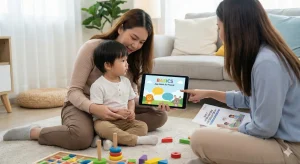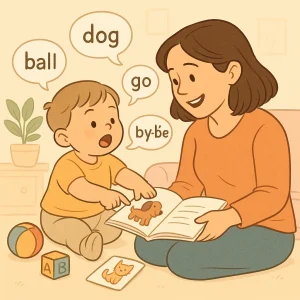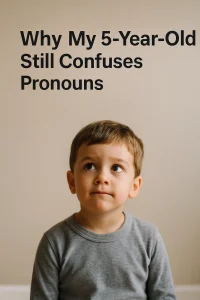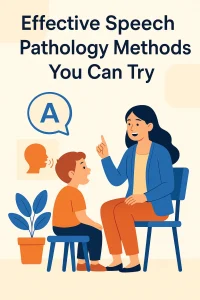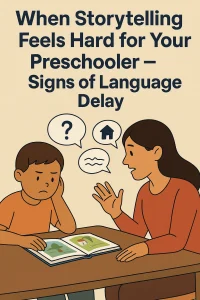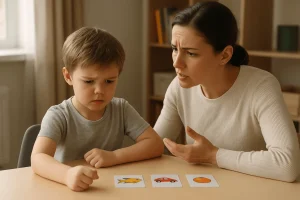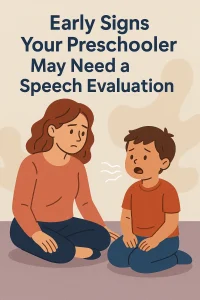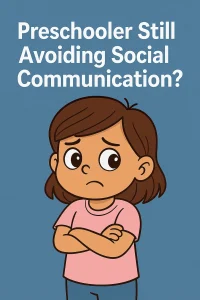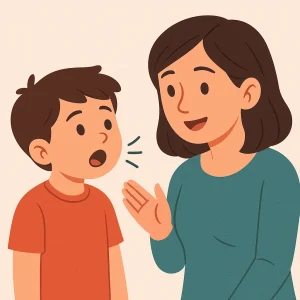My 2-Year-Old Doesn’t Pretend Play — Is That a Red Flag?
By Rajini D
Last Updated: August 19, 2025
“My child talks a little, but she doesn’t pretend to feed her dolls or act like a superhero like other kids her age. Should I be worried?”
If that question sounds familiar, you’re not alone. Many parents notice their 2-year-old doesn’t engage in pretend play and wonder if it could be a red flag for speech delay, social development issues, or even early signs of autism.
Pretend play—also called symbolic or imaginative play—is more than just cute make-believe. It’s actually a major milestone in toddler development, closely tied to language, social interaction, and cognitive growth.
Free Speech Help for Kids
Concerned about speech delays? Book a free consultation with our expert speech therapist and get guidance tailored to your child’s needs.
What Is Pretend Play and Why Is It Important?
Pretend play, also known as symbolic play, is when a child begins to use their imagination to act out scenarios, objects, or roles that aren’t real. It’s that magical moment when a spoon becomes a rocket ship, a banana turns into a phone, or your toddler pretends to feed their teddy bear breakfast.
At first glance, it might just seem like cute behavior—but it’s much more than that. Pretend play is a powerful milestone in your child’s development. It shows that their brain is beginning to connect ideas, emotions, and language in creative and meaningful ways. In fact, experts consider it one of the key pretend play milestones in early childhood.
When Does Pretend Play Start?
Most children begin to show signs of pretend play between 18 and 24 months of age. This might look very simple at first—like pretending to drink from an empty cup or making a doll “sleep.” These small acts are signs that your toddler’s imagination development is kicking in.
As they grow, their play becomes more elaborate and creative. By age 2.5 to 3, many children start creating full storylines: acting like doctors, cooking meals in toy kitchens, or pretending to be animals.
If your child is nearing age 2 and hasn’t started engaging in this kind of symbolic play, it might be something to keep an eye on—especially if they also show delays in speech or social interaction.
Examples of Pretend Play in Toddlers
- Feeding a stuffed animal or giving it a blanket
- Talking on a toy phone
- Pushing a toy car and making engine sounds
- Pretending to cook using kitchen sets or bowls
- Acting like a parent, doctor, or teacher
- Imitating animals by crawling and making animal noises
These simple play behaviors help toddlers learn how the world works, build empathy, and develop problem-solving and communication skills.
Why It Matter
Pretend play is more than entertainment—it’s a window into your child’s growing mind. It supports:
- Language development (they learn new words and ways to express ideas)
- Social skills (even solo play lays the foundation for interaction)
- Cognitive growth (they begin to plan, sequence, and act out scenarios)
If pretend play is missing beyond age 2, it doesn’t always mean something is wrong—but it could be an early indicator of a developmental delay, including autism spectrum disorder (ASD) or speech and language delays.
Is It Normal for a 2-Year-Old Not to Pretend Play?
It’s completely natural for parents to feel concerned if their 2-year-old shows no pretend play. You might notice other toddlers pretending to cook, talk on a toy phone, or rock a stuffed animal to sleep—while your child seems uninterested in make-believe games. So, is this something to worry about?
The answer isn’t always black and white. There is a wide range of normal behavior when it comes to how—and when—toddlers start pretend play. Some children jump into imaginative games early, while others need more time or the right kind of environment to explore pretend scenarios.
Parallel Play vs Pretend Play
To understand what’s typical, it helps to know the difference between parallel play and pretend play.
At around 18 to 30 months, many toddlers are still in the parallel play stage. This means they play side-by-side with other children, often using the same toys, but without interacting or pretending together. This is a totally normal and healthy part of social development.
On the other hand, pretend play—sometimes called symbolic play—involves using imagination to represent something else. For example, a toddler might pretend a block is a phone, or act like they’re feeding a toy animal. This stage usually emerges between 18 and 24 months, but the timing can vary.
So if your 2-year-old has no pretend play, but is otherwise curious, playful, and socially responsive, it may just be a matter of developmental timing.
When to Observe More Closely
While variation is normal, a lack of pretend play in toddlers—especially beyond age 2—can sometimes be an early sign of a developmental delay, including:
- Speech or language delay
- Social communication challenges
- Autism spectrum disorder (ASD)
Here are a few signs that might warrant a closer look:
- Your child doesn’t imitate actions (like waving, feeding a doll, or clapping)
- They don’t show interest in interacting with peers
- There’s little to no verbal or nonverbal communication
- No signs of imaginative or symbolic play by 2.5 years
If you notice these patterns, it’s worth discussing with your pediatrician or a developmental specialist. Early support—through speech therapy, play-based interventions, or even guided help from a speech therapy app—can make a big difference.
Gentle Encouragement Goes a Long Way
Some toddlers simply need more modeling, exposure, or interaction to unlock their pretend play skills. Try showing them how to “feed” a doll, pretend to stir a pot, or answer a toy phone. Even short sessions of guided pretend play can help spark their imagination.
And remember: pretend play isn’t just about toys—it’s about connection, creativity, and the building blocks of social and emotional development.
Lack of Pretend Play — Could It Be a Red Flag?
While every child develops at their own pace, a lack of pretend play in toddlers—especially beyond age 2—can sometimes be more than just a personality quirk. In some cases, it might be an early developmental red flag, signaling a need to look closer at how your child is progressing socially, emotionally, and cognitively.
Pretend play isn’t just fun—it’s a developmental marker that shows your toddler is beginning to understand symbols, process social roles, and explore their imagination. When this kind of play is absent or very delayed, it may indicate challenges that need attention.
Could It Be a Sign of Autism?
One of the early warning signs of autism spectrum disorder (ASD) is limited or absent pretend play. Children with autism may not show interest in symbolic or imaginative activities, such as pretending to feed a doll or acting like a character. Instead, they might focus on repetitive actions or show intense interest in objects without engaging in creative storytelling or role play.
That doesn’t mean every child who isn’t pretending at age 2 is autistic—but pretend play and autism are often linked in early evaluations. It’s one of several behaviors professionals look at when assessing for ASD.
What About Speech or Cognitive Delays?
Pretend play depends heavily on language and thinking skills. If a child has a speech delay, they may struggle to express or act out ideas—even if they understand them internally. Similarly, cognitive delays can affect a child’s ability to connect actions with imagination or mimic real-life scenarios in play.
So, a child who isn’t engaging in pretend play may not just be disinterested—they might be delayed in key areas of development that support imagination, expression, and social awareness.
Developmental Red Flags in Toddlers: What to Watch For
If your 2-year-old isn’t engaging in pretend play, it’s helpful to look at the bigger picture. Here’s a quick developmental red flag checklist that might signal a need for further evaluation:
- No pretend or symbolic play by 24–30 months
- Limited eye contact or social interaction
- Doesn’t imitate actions or gestures (like waving or clapping)
- Few or no words by age 2
- Doesn’t respond to name or avoids joint attention
- Repetitive play (lining up toys, spinning wheels) without imagination
- Limited interest in interacting with peers or adults
If two or more of these apply to your child, consider speaking to your pediatrician or a child development specialist. The goal is not to label your child—but to offer support early, when it can make the most impact.
The Bottom Line
Pretend play is a powerful window into a toddler’s inner world. When it’s missing, especially along with other signs like limited speech or social difficulties, it could be pointing toward something more.
That said, it’s important not to panic. Some children catch up quickly with the right support. Tools like the BASICS App, designed by speech and developmental experts, can also help encourage imaginative play and improve communication at home.
Pretend Play and Autism — What’s the Connection?
Many parents searching for answers about their toddler’s development come across a common concern: “Is the lack of pretend play a sign of autism?” It’s a valid and important question.
There is a strong link between pretend play and autism, particularly in how it relates to social, emotional, and communication skills. Children on the autism spectrum often struggle with symbolic thinking, imagination, and joint interaction, which are all essential parts of pretend play.
Why Pretend Play Matters for Social Development
Pretend play isn’t just about being silly—it’s a foundational skill that supports how children:
- Understand emotions
- Express ideas
- Interact with others
- Practice everyday social roles
When a toddler pretends to feed a doll, they are not just playing—they’re learning empathy, role modeling, and developing theory of mind (the ability to understand that others have thoughts and feelings). These are essential social tools that typically emerge in early childhood.
Book Free Autism Session
Concerned about your child’s development? Talk to our autism expert online for free. Get personalized consultation and expert next steps.
Autism Signs and the Lack of Pretend Play
Many studies have shown that children with autism spectrum disorder (ASD) often show a lack of pretend play or use it in repetitive, non-social ways. For example, instead of pretending that a toy car is driving to the store, a child with autism might spin its wheels over and over or line up toys without storytelling.
This absence of symbolic or imaginative play is one of the early behavioral signs professionals look for during developmental screenings.
According to the CDC and other autism research centers, red flags related to pretend play include:
- Not using objects symbolically (e.g., pretending a block is a phone)
- Avoiding or ignoring pretend social interactions
- Lack of “playing with” others—only playing next to or alone
- Difficulty sharing attention or looking where others are pointing (lack of joint attention)
What Parents Should Watch For
Here are some real-life behavioral signs linked to pretend play and autism:
- Your child isn’t pretending, even when shown how
- They play with toys in rigid or repetitive ways
- They don’t make eye contact or share focus with you during play
- They don’t show interest in what others are doing nearby
If these behaviors sound familiar, it doesn’t mean your child has autism—but they do suggest it’s time to observe more closely and consult a developmental specialist.
How to Support Pretend Play
The good news? Pretend play can be encouraged. With time, guidance, and the right tools—like play therapy, parent modeling, or even an autism support app—many children begin to explore symbolic play more naturally.
Apps like BASICS, for example, offer guided storytelling and social modeling, helping children understand pretend play through relatable visuals and activities.
Other Signs of Autism or Developmental Delays in Toddlers
While the lack of pretend play can be an early clue, it’s just one piece of a much larger developmental picture. If you’re concerned about your child’s behavior, It helps to be aware of other early signs of autism in toddlers — especially between 18 and 36 months.
Every child is different, but when several developmental skills seem delayed or missing altogether, it may point to autism spectrum disorder (ASD) or other developmental conditions like speech and language delays.
Common Signs of Autism in Toddlers
Here are some key behaviors that may raise concern—especially when observed consistently:
- Limited or no eye contact
- Does not point to show interest or share attention (by 12–18 months)
- Delayed speech development or very few words by age 2
- Does not respond to their name being called
- Avoids social interaction (prefers being alone, doesn’t show interest in peers)
- Repetitive behaviors, like flapping hands, spinning toys, or lining up objects
- Lack of gestures (no waving, clapping, or nodding)
- Unusual sensitivity to sounds, lights, or textures
- No signs of pretend play, storytelling, or symbolic thinking
These symptoms don’t always mean a child is autistic—but a pattern of several red flags may warrant a closer look from a pediatrician or child development expert.
Speech Delay in Toddlers: A Common Co-Occurring Sign
Among all developmental concerns, one of the most common and noticeable is a speech delay in toddlers. If your child isn’t speaking as expected—or isn’t combining words by 2 years old—it may or may not be tied to autism, but it still deserves attention.
Speech delay can appear on its own or alongside other signs of autism. For example, your child might:
- Use only a few words or no words at all
- Struggle to follow simple instructions
- Show little interest in copying sounds or words
- Seem frustrated when trying to express needs
If your child has both a speech delay and a lack of pretend play, it’s especially important to track their progress and consider an early evaluation.
What Should Parents Do?
It’s natural to hope your child will “catch up”—and many do. But if you’re seeing several red flags, don’t wait. Early support makes a huge difference.
Talking to your pediatrician is the first step. They may recommend a speech-language evaluation, developmental screening, or early intervention programs. You can also begin practicing key skills at home through speech therapy apps, parent-led play, or professional-guided resources.
How to Encourage Pretend Play at Home
If your toddler is not engaging in pretend play, don’t panic. Some children need a little help getting started—especially if they’re shy, delayed in speech, or unsure how to begin.
The good news is, pretend play can be gently introduced and nurtured right at home. With the right approach, even a few minutes of play each day can make a big difference in building your child’s imagination, language, and social confidence.
Also read: Pretend Play Ideas for Late Talkers: Build Speech Skills Naturally
Start by Modeling Pretend Play Yourself
Children learn best by watching what adults do. If your toddler isn’t naturally pretending yet, they may need you to show them how.
Here’s how to model pretend play:
- Pick up a stuffed animal and pretend to feed it or rock it to sleep
- Pretend to cook using a pot and spoon, narrating your actions (“Mmm, this soup is hot!”)
- Use a toy phone and pretend to call grandma
- Act out being a doctor or teacher, using simple phrases your child can imitate
You don’t need fancy props—just your imagination, enthusiasm, and willingness to be a little silly.
Toddler Pretend Play Ideas (That Work!)
If you’re looking for fresh ways to help your child explore imaginative play, try these simple and engaging pretend play ideas:
| Activity | How to Do It |
|---|---|
| Doll or Animal Care | Pretend to feed, bathe, or put a toy to bed. Let your toddler copy your actions. |
| Kitchen Play | Use toy or real kitchen tools. Stir, bake, serve pretend meals together. |
| Supermarket Game | Use a bag and some empty containers. Pretend to shop, scan, and pay. |
| Doctor Visit | Take turns being the doctor and patient. Use a spoon or toy as a thermometer. |
| Construction Play | Use blocks to “build a house” or “fix the road.” Add sound effects for fun. |
| Animal Imitation | Crawl like a cat, hop like a bunny, or roar like a lion together. |
These games not only spark creativity but also support speech and social development, especially when paired with simple words and expressions your child can understand.
Make Pretend Play Part of Everyday Routines
One of the easiest ways to build pretend play is to weave it into real-life situations:
- During bath time, pretend a toy fish is swimming away
- At snack time, offer a pretend bite to a teddy bear
- In the car, imagine you’re driving to the zoo or space!
Even if your child doesn’t join in at first, they’re watching—and learning. Over time, they may begin to copy your actions, then invent their own.
What If My Toddler Still Doesn’t Engage?
If your toddler is still not engaging in pretend play despite encouragement, it may be worth observing other behaviors. Are they trying to communicate? Showing interest in others? Responding to their name?
Sometimes a child needs extra support, especially if pretend play is delayed alongside speech delays or social difficulties. In these cases, tools like the BASICS App—which combines speech therapy techniques with interactive storytelling—can gently guide children into imaginative thinking through visuals, sounds, and structured activities.
Can an App Help If My Child Isn’t Pretending to Play?
If your toddler is not showing interest in pretend play, you may be wondering if technology can offer some support. While screen time for young children should always be guided and limited, the right kind of speech therapy app for toddlers can actually be a helpful tool—especially when it’s designed by child development experts.
Apps that focus on symbolic play, communication, and interaction—like the BASICS App—can provide a structured yet playful way to gently guide your child toward developmental milestones.
How Can an App Support Pretend or Symbolic Play?
Symbolic play is when a child uses one thing to represent another—like pretending a block is a phone, or using a spoon to “feed” a toy bear. Many toddlers who are delayed in this area need clear models, repetition, and simple, visual examples to understand the concept.
That’s where apps designed for developmental support can shine. A well-crafted autism app for toddlers or speech therapy tool can:
- Show pretend play through guided animations or real-child demos
- Offer interactive stories that encourage imagination and dialogue
- Provide prompts and visuals for role-playing and simple actions
- Reinforce communication skills using everyday play scenarios
By using bright visuals, clear sounds, and step-by-step activities, these tools give toddlers the opportunity to watch, imitate, and gradually explore imaginative play at their own pace.
Supporting Speech and Social Development at the Same Time
Many apps go beyond pretend play—they also target speech delay, nonverbal communication, and social engagement. This is especially important for children who may not yet talk but are trying to communicate in other ways.
For example, a good app for delayed speech might:
- Help toddlers recognize familiar words through repeated use
- Encourage turn-taking, labeling, and simple expressions
- Use visual schedules or choice boards to support understanding
- Reward imitation and interaction—key steps toward speech development
Some apps even let you track your child’s progress, offering daily activities or therapist-recommended exercises you can try at home.
Why Online Speech Therapy Apps Are Gaining Popularity
In recent years, more parents have turned to online speech therapy tools and digital early intervention programs for several reasons:
- Convenience: You can use them anytime, anywhere—even during daily routines.
- Consistency: Regular practice, even just 10–15 minutes a day, makes a difference.
- Engagement: Young children love visuals, music, and interactive activities.
- Parent-led: Many apps empower parents to guide sessions without needing formal training.
Apps like BASICS are built with the input of speech therapists, occupational therapists, and early educators to ensure that each activity supports real developmental goals—like boosting imagination, encouraging symbolic play, and building early communication skills.
The Bottom Line
If your child isn’t pretending to play yet, you’re not alone—and you’re not without options. The right online speech therapy app for toddlers or autism support app can be a practical and playful way to introduce these skills, especially when used alongside real-life interaction, modeling, and guided play.
Always remember: apps are tools—not replacements for parenting, connection, or professional evaluation. But when used thoughtfully, they can offer real progress, one small step at a time.
When Should I Talk to a Specialist or Therapist?
If your toddler isn’t engaging in pretend play—or if you’ve noticed other early signs of autism or developmental delays—it’s completely valid to have questions. As a parent, trusting your gut is important. You know your child best. And if something doesn’t feel right, getting a professional opinion early can make all the difference.
When to Consider a Developmental Evaluation
Not every delay means something serious. But if your child is:
- Not talking much or at all by age 2
- Not making eye contact or responding to their name
- Showing a lack of pretend play or interest in others
- Not pointing, waving, or using simple gestures
- Repeating actions in unusual ways or seeming “in their own world”
…these may be early signs of autism or other developmental concerns. You don’t need to wait for things to get worse. Instead, consider requesting a developmental evaluation.
A formal evaluation can help identify:
- Language or speech delays
- Social and emotional challenges
- Sensory issues
- Autism spectrum traits
And the best part? It gives you clarity—and a plan.
Who Can Help?
The first step is often your pediatrician. They can:
- Track your child’s developmental milestones
- Rule out hearing or medical issues
- Refer you to the right specialists if needed
If your doctor sees potential concerns, they may guide you to:
- A developmental therapist – who focuses on play, motor skills, and early learning
- A speech-language pathologist (SLP) – who evaluates communication and offers support
- A child psychologist or developmental pediatrician – for more in-depth autism screening
You can also search for support directly using terms like “speech therapy near me” or “early intervention services in [your city]”. Most early intervention programs are free or low-cost and don’t require a diagnosis to begin.
Why Early Intervention Matters
When it comes to developmental delays, early help is powerful help. Research consistently shows that children who receive support before the age of 3 make more progress in communication, learning, and social skills than those who start later.
Early intervention can:
- Improve speech and language skills
- Support pretend play and imagination
- Build attention, interaction, and emotional regulation
- Reduce frustration (for both the child and the parent)
Whether it’s working with a professional in person or using supportive tools like a speech therapy app, the key is to act early—while your child’s brain is still in its most flexible and adaptable stage.
Conclusion
If your toddler isn’t pretending to play, don’t panic. Every child grows differently, and some just need more time. But if you’re worried, trust your gut—it’s okay to ask questions. Watch your child closely and talk to a specialist if needed.
Early support can really help, especially with things like speech delay or social development. Try using a helpful tool like the BASICS App—a trusted speech therapy app for toddlers that builds skills through fun and easy play.
Start early, stay curious, and know you’re doing the right thing for your child.
Frequently Asked Questions:
1. Is it normal if my 2-year-old doesn’t do pretend play?
Yes, some toddlers take more time to start pretend play. But if your child is not pretending at all and also has other delays—like limited speech or poor eye contact—it’s best to speak with your pediatrician.
2. Can lack of pretend play mean autism?
Sometimes, yes. Lack of pretend play in toddlers can be one of the early autism signs, especially if your child also avoids eye contact, doesn’t point, or shows little interest in others.
3. At what age should toddlers start pretend play?
Most toddlers begin simple pretend or symbolic play around 18 to 24 months. This includes things like pretending to feed a doll or talk on a toy phone.
4. What does pretend play look like in a 2-year-old?
Examples of pretend play in toddlers include:
- Feeding stuffed animals
- Cooking with toy kitchen items
- Talking on a toy phone
- Pretending to be a parent or doctor
5. Why is pretend play important for toddlers?
Pretend play helps with language development, social skills, and problem-solving. It shows that your child is learning to think creatively and understand the world around them.
6. My toddler has no pretend play and doesn’t talk—should I worry?
If your child shows no pretend play and also has a speech delay, it may be time for a developmental evaluation. Early support can help your child catch up.
7. How can I teach my toddler to pretend play?
You can model pretend play by:
- Feeding a toy
- Pretending to cook
- Talking to a stuffed animal
Start small, keep it fun, and repeat often.
8. Can a speech therapy app help with pretend play?
Yes. A good speech therapy app for toddlers, like the BASICS App, can guide your child through play-based activities that build imagination, speech, and social skills.
9. Should I get my child evaluated if they don’t pretend play?
If your child is over 2 and still not pretending—even after you model it—it’s a good idea to talk to your pediatrician or a speech therapist for guidance.
10. Where can I find speech therapy near me for toddlers?
You can ask your child’s doctor for a referral or search online for “speech therapy near me.” Many areas also offer free early intervention services if your child is under 3.
About the Author:
Rajini Darugupally
M.Sc., Speech-Language Pathologist (9+ years of experience)
Rajini is a passionate and dedicated Speech-Language Pathologist with over 9+ years of experience, specializing in both developmental speech and language disorders in children and rehabilitation in adults. Driven by a desire to empower each individual to find their voice, Rajini brings a wealth of experience and a warm, genuine approach to therapy. Currently, at Wellness Hub, she thrives in a team environment that values innovation, compassion, and achieving results for their clients.
Book your Free Consultation Today
Parent/Caregiver Info:
Client’s Details:
* Error Message
